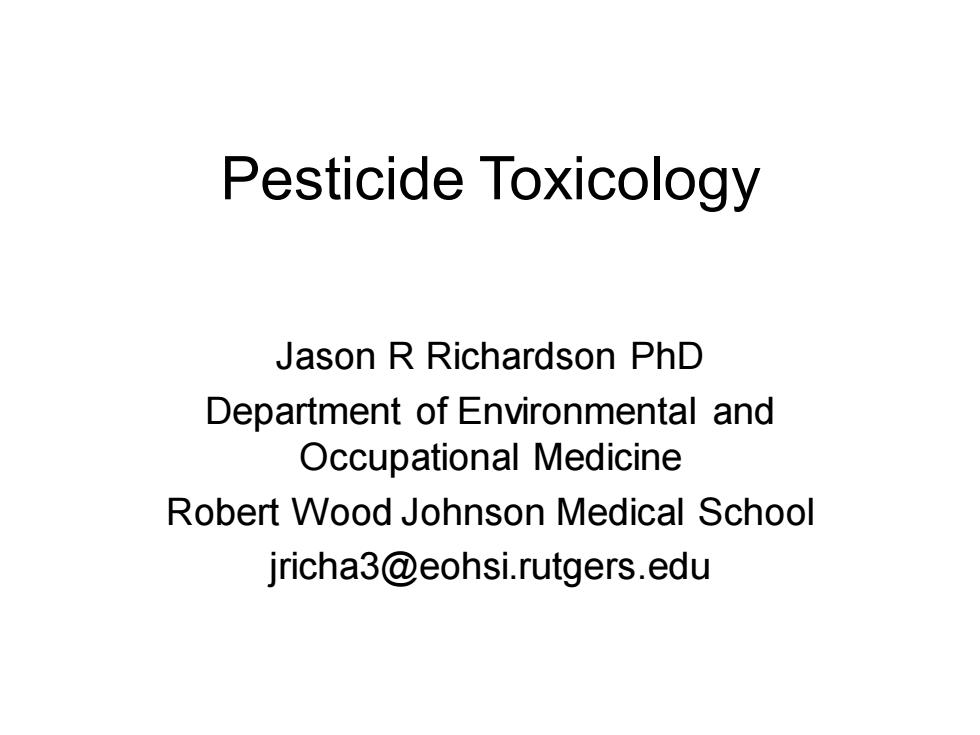
Pesticide Toxicology Jason R Richardson PhD Department of Environmental and Occupational Medicine Robert Wood Johnson Medical School jricha3@eohsi.rutgers.edu
Pesticide Toxicology Jason R Richardson PhD Department of Environmental and Occupational Medicine Robert Wood Johnson Medical School jricha3@eohsi.rutgers.edu
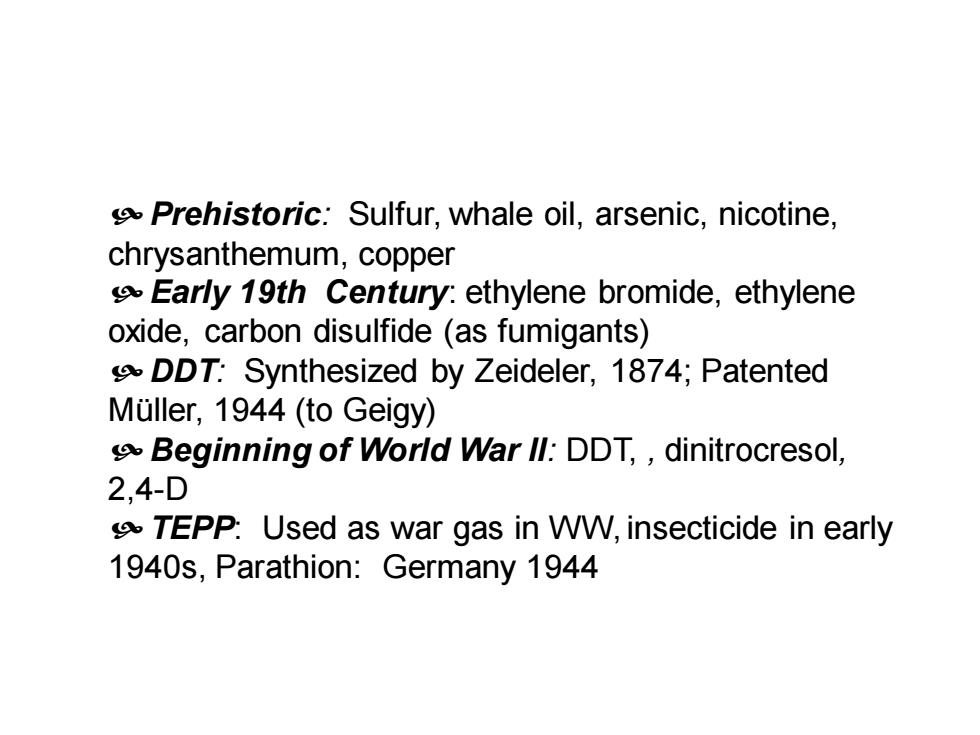
Prehistoric:Sulfur,whale oil,arsenic,nicotine, chrysanthemum,copper Early 19th Century:ethylene bromide,ethylene oxide,carbon disulfide (as fumigants) DDT:Synthesized by Zeideler,1874;Patented Muller,1944(to Geigy) Beginning of World War Il:DDT,dinitrocresol, 2,4-D TEPP:Used as war gas in WW,insecticide in early 1940s,Parathion:Germany 1944
Prehistoric: Sulfur, whale oil, arsenic, nicotine, chrysanthemum, copper Early 19th Century: ethylene bromide, ethylene oxide, carbon disulfide (as fumigants) DDT: Synthesized by Zeideler, 1874; Patented Müller, 1944 (to Geigy) Beginning of World War II: DDT, , dinitrocresol, 2,4-D TEPP: Used as war gas in WW, insecticide in early 1940s, Parathion: Germany 1944
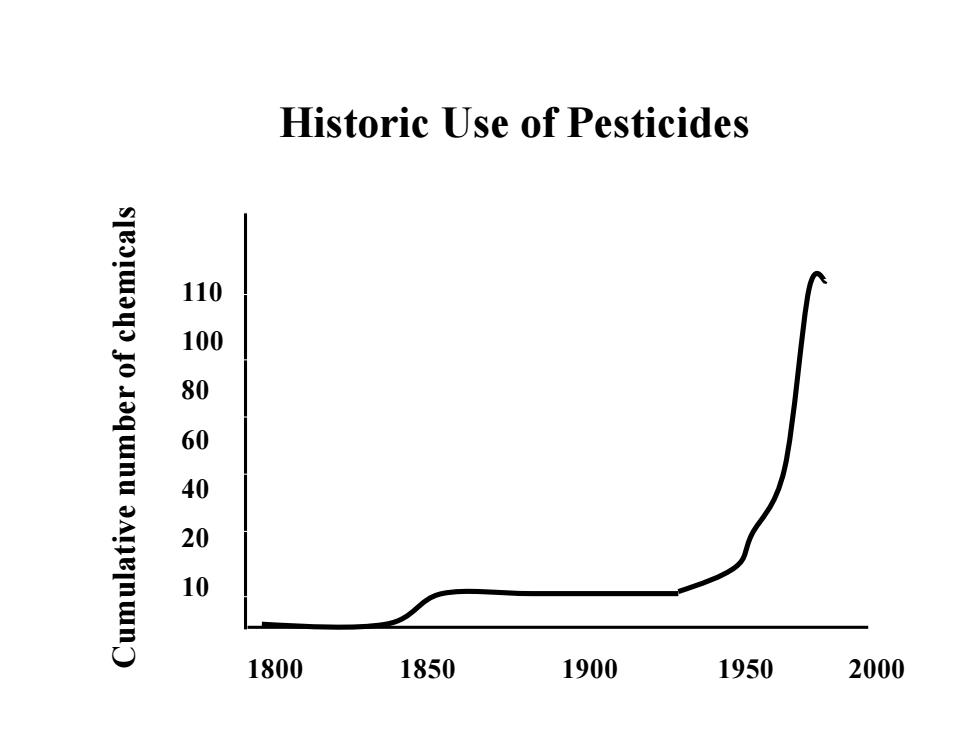
Historic Use of Pesticides slesrwoq5 Jo oqwnu SAIelnwn 110 100 80 60 40 20 10 1800 1850 1900 1950 2000
Cumulative number of chemicals 1800 1850 1900 1950 2000 110 100 80 60 40 20 10 Historic Use of Pesticides

US Pesticide Use Soasonnl 。4.5 billion pounds chemicals per year -890 active ingredients, 30,000 formulations Uses ·75%agricultural ·25%home,garden, structural
US Pesticide Use • 4.5 billion pounds chemicals per year – 890 active ingredients, 30,000 formulations – Uses • 75% agricultural • 25% home, garden, structural
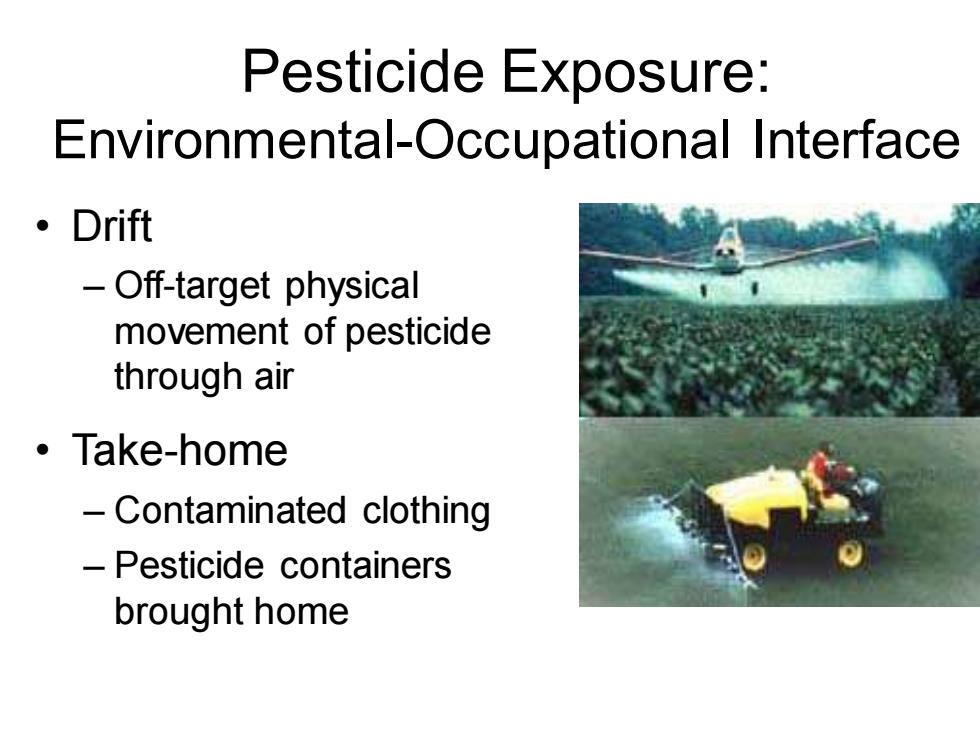
Pesticide Exposure: Environmental-Occupational Interface 。Drift Off-target physical movement of pesticide through air ·Take-home -Contaminated clothing -Pesticide containers brought home
Pesticide Exposure: Environmental-Occupational Interface • Drift – Off-target physical movement of pesticide through air • Take-home – Contaminated clothing – Pesticide containers brought home
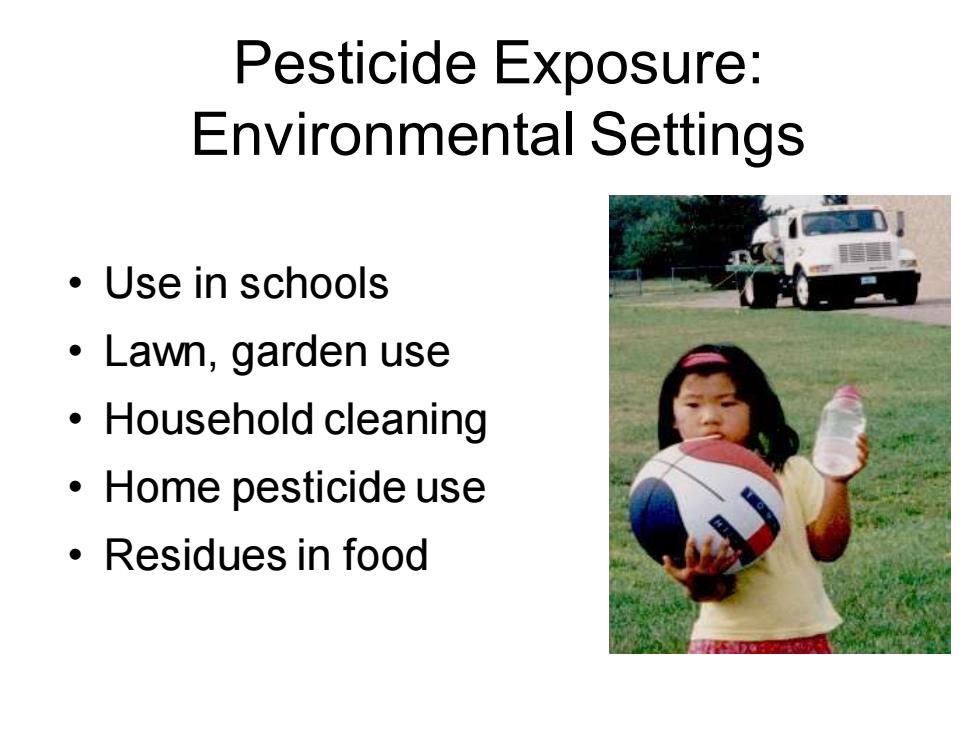
Pesticide Exposure: Environmental Settings ·Use in schools ·Lawn,garden use 。Household cleaning ·Home pesticide use ·Residues in food
Pesticide Exposure: Environmental Settings • Use in schools • Lawn, garden use • Household cleaning • Home pesticide use • Residues in food
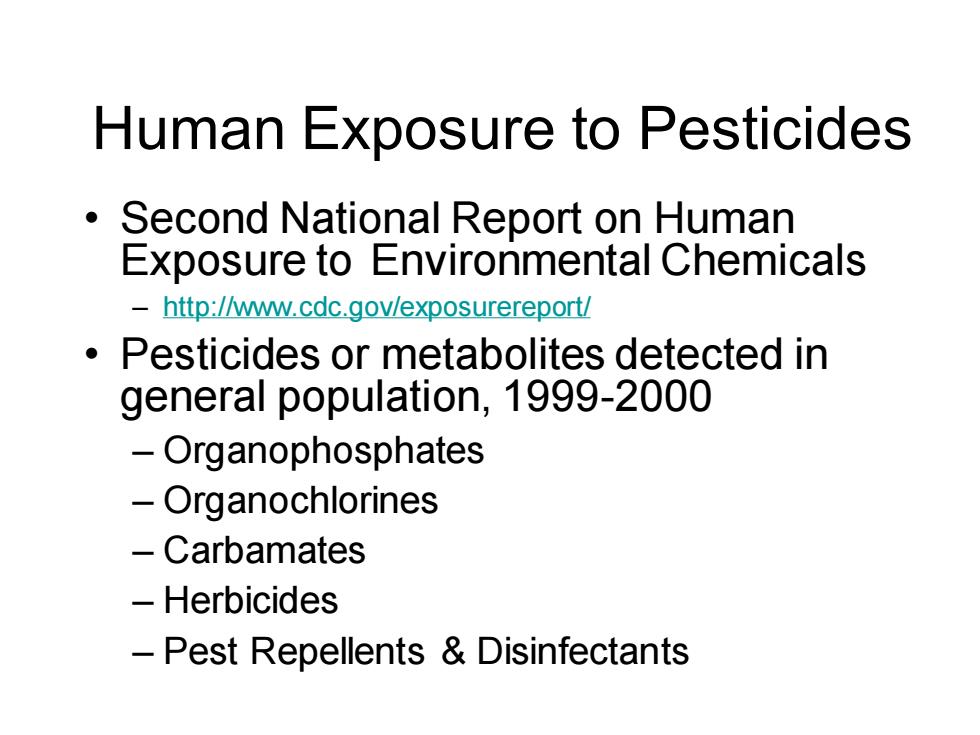
Human Exposure to Pesticides Second National Report on Human Exposure to Environmental Chemicals -http://www.cdc.gov/exposurereport/ Pesticides or metabolites detected in general population,1999-2000 -Organophosphates -Organochlorines -Carbamates -Herbicides -Pest Repellents Disinfectants
Human Exposure to Pesticides • Second National Report on Human Exposure to Environmental Chemicals – http://www.cdc.gov/exposurereport/ • Pesticides or metabolites detected in general population, 1999-2000 – Organophosphates – Organochlorines – Carbamates – Herbicides – Pest Repellents & Disinfectants
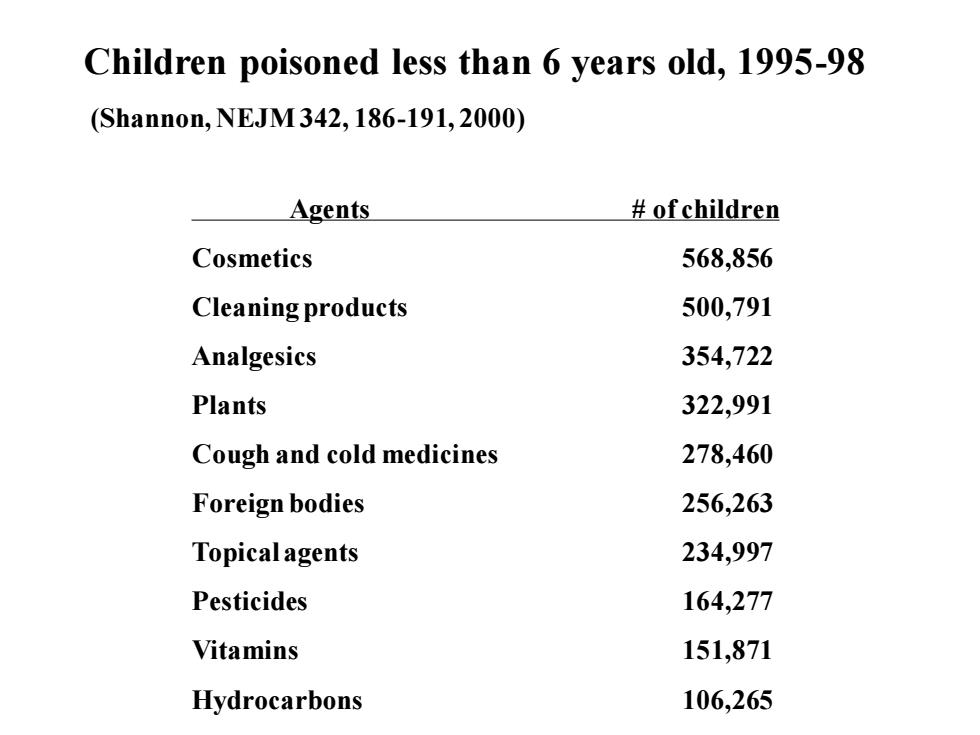
Children poisoned less than 6 years old,1995-98 (Shannon,NEJM342,186-191,2000) Agents of children Cosmetics 568,856 Cleaning products 500,791 Analgesics 354,722 Plants 322,991 Cough and cold medicines 278,460 Foreign bodies 256,263 Topical agents 234,997 Pesticides 164,277 Vitamins 151,871 Hydrocarbons 106,265
Children poisoned less than 6 years old, 1995-98 (Shannon, NEJM 342, 186-191, 2000) Agents # of children Cosmetics 568,856 Cleaning products 500,791 Analgesics 354,722 Plants 322,991 Cough and cold medicines 278,460 Foreign bodies 256,263 Topical agents 234,997 Pesticides 164,277 Vitamins 151,871 Hydrocarbons 106,265
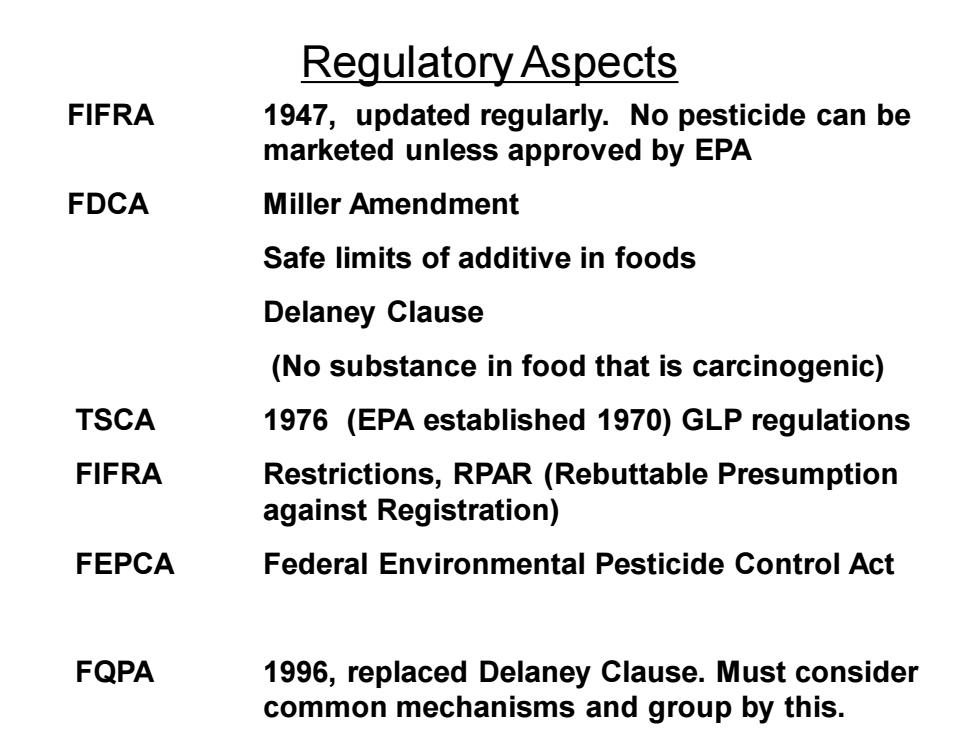
Regulatory Aspects FIFRA 1947,updated regularly.No pesticide can be marketed unless approved by EPA FDCA Miller Amendment Safe limits of additive in foods Delaney Clause (No substance in food that is carcinogenic) TSCA 1976 (EPA established 1970)GLP regulations FIFRA Restrictions,RPAR(Rebuttable Presumption against Registration) FEPCA Federal Environmental Pesticide Control Act FQPA 1996,replaced Delaney Clause.Must consider common mechanisms and group by this
FIFRA 1947, updated regularly. No pesticide can be marketed unless approved by EPA FDCA Miller Amendment Safe limits of additive in foods Delaney Clause (No substance in food that is carcinogenic) TSCA 1976 (EPA established 1970) GLP regulations FIFRA Restrictions, RPAR (Rebuttable Presumption against Registration) FEPCA Federal Environmental Pesticide Control Act FQPA 1996, replaced Delaney Clause. Must consider common mechanisms and group by this. Regulatory Aspects

US EPA Toxicity Classification (Systemic toxicity,eye irritation,skin irritation) ·Class:“Danger” -Fatal if ingested;corneal opacity;corrosive to skin Class II:Varning” May be fatal if ingested;reversible corneal opacity; severe skin irritation 。Class Ill:“Caution” -Harmful if ingested;no corneal opacity;moderate skin irritation 。Class IV:“Caution” May be harmful if ingested;no eye irritation; mild/no skin irritation
US EPA Toxicity Classification (Systemic toxicity, eye irritation, skin irritation) • Class I: “Danger” – Fatal if ingested; corneal opacity; corrosive to skin • Class II: “Warning” – May be fatal if ingested; reversible corneal opacity; severe skin irritation • Class III: “Caution” – Harmful if ingested; no corneal opacity; moderate skin irritation • Class IV: “Caution” – May be harmful if ingested; no eye irritation; mild/no skin irritation